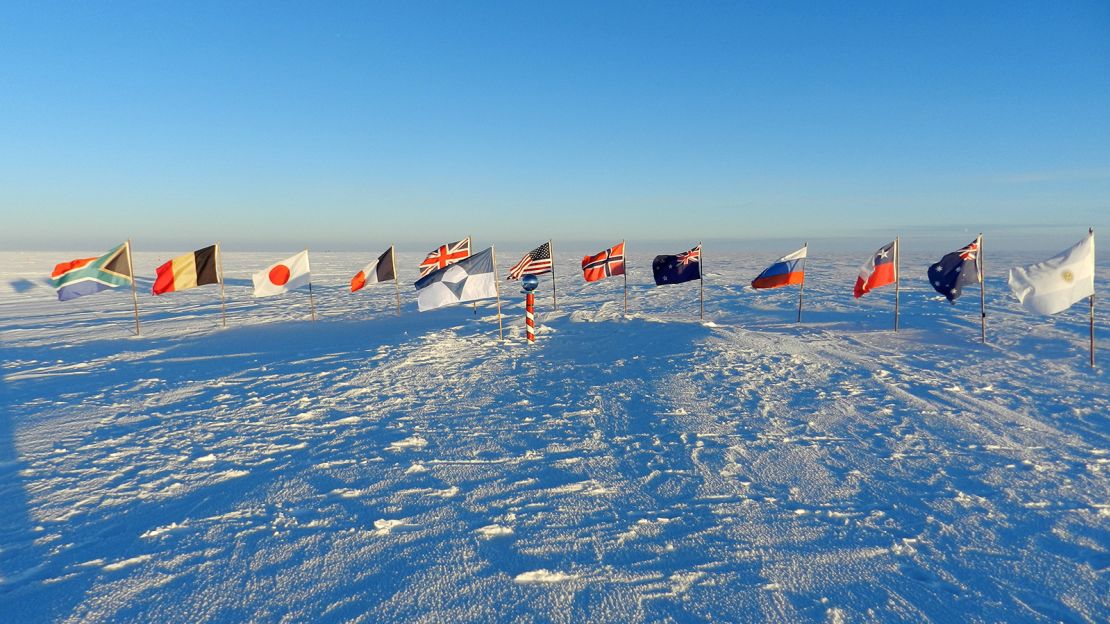As long as humans have known of its existence, they have wanted to visit Antarctica.
It is the world’s least visited, least populated continent. On the best day, it is extremely hard to get to. And yet, the appeal of the unknown and the desire to set foot on every continent have encouraged travelers to try and make their way to the South Pole.
Still, for the obsessive catalogers of the world, Antarctica is difficult to classify. It’s not a country, so can you cross it off a bucket list? Who controls it? If it had a capital city, where would it be? What would be the native language?
A national flag for a nation-less place
These were among the questions that Evan Townsend posed to himself when he signed up for the first of two stints working at McMurdo Station, the US-run base in Antarctica.
Townsend, an elementary school teacher in Boston, knew he had a strict baggage limit when going to Antarctica to work as a support staffer – everyone is limited to 85 pounds, he says, which has to include clothes, toiletries, medicine, electronics and anything else they might want or need during their stay.
As one of his duties would be managing the arts and crafts room on base, he wanted to bring some decorations with him, but knew he needed to keep it light. Townsend chose the Pride flag – it weighed almost nothing, but its significance was heavy.
One day, Townsend and a few colleagues took the Pride flag outside and snapped photos of themselves to post on social media. The photos ended up becoming an international story, with many news outlets saying the outing was Antarctica’s first-ever Pride parade.
“That was when I realized the power of flags,” Townsend says. “On one hand, I’m completely isolated at the end of the Earth. And on the other hand, I’m part of this global community.”

Despite not having a background in design, Townsend identifies as a longtime “flag nerd” and began to toy with the idea of creating a flag to represent Antarctica.
He went with dark blue for the Southern Ocean waters and white for the landscape, with an isosceles triangle in the center to represent Antarctica’s icy peaks.
“I wanted it to be a neutral flag, for sure,” Townsend says. “It’s a distinct design, it’s a distinct color, to make sure that it’s not affiliated with any particular group or nationality. I wanted it to be something that had a lot of symbolism, but that was simple enough that people could apply their own perception of Antarctic and their own understanding of the continent to the flag.”

The name of the flag project, True South, also has its own significance.
“‘True south’ literally means the direction toward the geographic south pole, as opposed to magnetic south which would lead to the magnetic south pole,” Townsend explains. “it’s meant to represent the shared goals and values by which the Antarctic community can orient itself.”
And Townsend has no plans to trademark or copyright the flag’s design, as he believes it should belong to the whole world.
“The best flags are flags that get their meaning and their power from the people that fly them,” he adds.
Who’s in charge here, anyway?
Townsend is just one of the many people around the globe who are transfixed by Antarctica, even if they are never able to visit and see the place for themselves.
So, what is it about the southernmost continent that continues to entrance people?
In a world that’s more interconnected than ever, Antarctica remains one of the few places that most people don’t know anything about.
There is no indigenous population in Antarctica, and human activity there is still relatively recent.
The only permanent installations are a handful of scientific stations, which only employ scientists and their support staff – a term comprising anyone from chefs and maintenance workers to electricians and airport managers.
It’s common for people to multitask. Townsend worked in food service, as a bartender and as a craft room manager during his tenure. At its peak, the number of human Antarctic residents is approximately 10,000.
In 1959, 12 countries – including Japan, South Africa, France, the United Kingdom, Argentina and what was then the USSR – signed the Antarctic Treaty in Washington, DC.
Among the items they agreed on was that that Antarctica should “be used for peaceful purposes only” and that science would be at the forefront of any development or settlement there. Members of the military are allowed to be there, but only in support roles.
Although few people live there, Antarctica’s scope of influence is massive. Climate change has caused the continent to shrink. And despite the treaty’s existence, world politics have changed and new power players – namely China – have emerged in Antarctica.

Klaus Dodds, professor of Geopolitics at the University of London, is the author of several books about the polar regions, most recently “The Arctic: A Very Short Introduction,” co-authored with Jamie Woodward.
“Stuff just keeps being taken from Antarctica. Information, ice, resources like seals and whales and fish,” he says. “Antarctica’s fragility, I think, represents the fragility of the wider world.”
While climate change is the biggest influence on Antarctica, there’s another major factor that will only grow more significant as the pandemic ebbs – tourism.
The future of the seventh continent
About 90% of tourists to Antarctica come by boat. These trips are expensive, and most travelers spend only a few hours actually on the land before getting back on the ships and turning around.
Currently, the United States is the single largest source of Antarctic tourism, but China is quickly rising into second place, and Dodds believes within in a decade it will top the list.
Some destinations, like Argentina resort town Ushuaia and Australia’s Hobart, make money from these tourists due to their location as final pre-Antarctic ports of call. Dodds predicts that the next decade will see multiple cruise ship companies open up Antarctica itineraries and more travel companies invest in the continent’s infrastructure.
Just as countries jockey for power with military bases and political maneuvers, Antarctica has become another site for their rivalries – and fears – to play out.
“Nobody can answer the question (of) who owns Antarctica,” Dodds says.
“I think the Antarctic represents, in essence, not just the idealism that the treaty represents, but it also represents the supreme contradictory nature of humanity more generally. So for all the things we wish to celebrate in Antarctica, there’s also the ugliness of humanity.”
He points to a few major successes: Antarctica was the first continent to be completely free of nuclear weapons. It is also demilitarized.
Another example of the continent’s potential for beauty and unity? The True South flag, which Dodds admires.
“(It) is a well-intentioned reminder that Antarctica is a marvel. Antarctica should represent the very best in all of us.”







